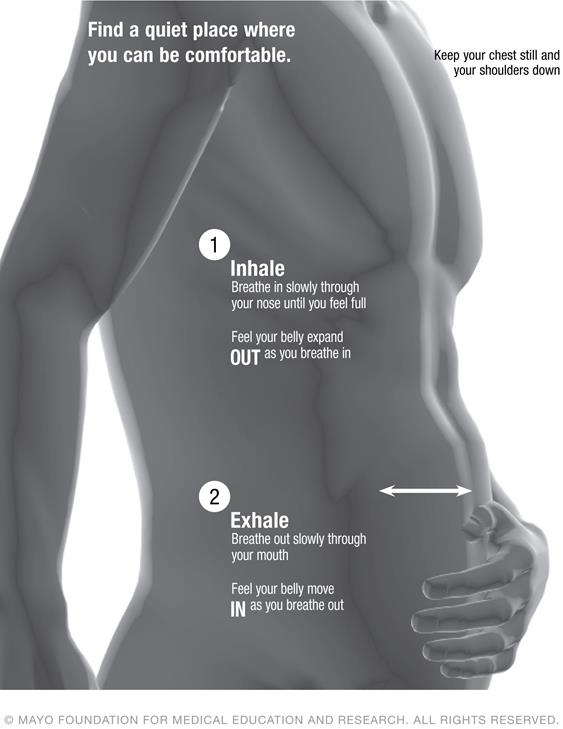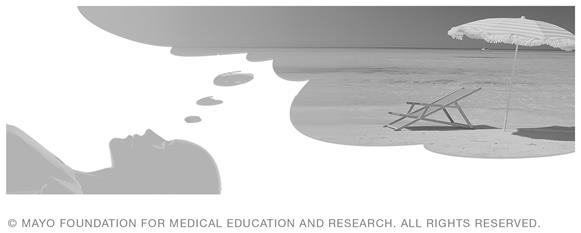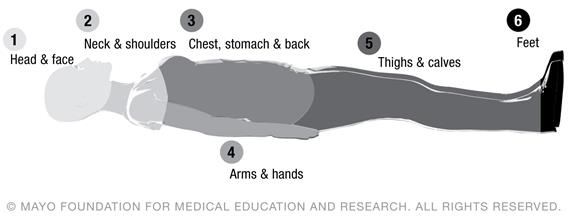Using Relaxation Skills to Relieve Your Symptoms
How Does Relaxing Help You?
Many people think of “relaxing” as simply getting away from stressors.But did you know that when you truly relax, you change your physical and emotional reactions to stress?It’s true.Relaxing is more than a “nice to do” idea.
When you realize you need to relax, which of these physical or emotional symptoms are you having?
- Increased heart rate and blood pressure.
- High stress or anxiety.
- Increased pain.
- Muscle tightness.
- Sense of being overwhelmed.
- Difficulty sleeping.
- Difficulty focusing on tasks; poor thinking.
What can you do?
If you’re dealing with any of the symptoms listed above, you can get relief — by learning relaxation skills.
Using relaxation skills can:
- Reduce stress, pain, anxiety, fatigue, and nausea.
- Improve energy, attention, mood, concentration, and sleep.
Three very effective ways to help the body relax are explained here: relaxed breathing, guided imagery and two types of muscle relaxation. With regular practice — when you’re not already stressed — you can quickly learn how to use these methods whenever and wherever needed.
|
When you know how to relax, |
What Happens When You Are Stressed?
When you have physical or emotional symptoms, your body naturally wants to reduce the discomfort and make you feel better. So it quickly moves into decision-making mode. This is often called the “fight or flight” moment.
Fight-or-flight is the body’s medically proven reaction to physical and emotional discomfort.
Will you “fight” as a reaction to the stress?
Fighting may be real fighting, like kicking or screaming.Or it could be less obvious, such as being rude or picking a fight for no reason.Fighting may not even be related to the stressor.For example, you may yell at a friend about a lost book, but you’re actually stressed about work — and you can’t yell at your boss.
Will your body take flight?
Taking “flight” may mean walking out on an argument or quitting a job or activity. Or it could be a way to avoid the situation. For example, some people sleep more than needed. Other people distract themselves with too much TV or time on the Internet.
How can you get relief from your symptoms?
Each of these examples of “fight or flight” — yelling, kicking, doing something reckless, walking out, and distracting oneself — is the body’s effort to reduce your stress. But most often, fight or flight activities have negative aspects too.
The best way to help yourself —the best way to reduce your own symptoms —is to avoid that moment when the body automatically begins its fight-or-flight decision making!
When you are relaxed, you are “in a physical state of deep rest that changes your physical and emotional responses to stress.” This is called the body’s “relaxation response.” In this state, the:
- Heart rate slows, leading to less work for the heart.
- Blood pressure lowers.
- Breathing rate slows, becomes calmer.
- Body has less need for oxygen.
- Muscles relax.
- Major muscles get more blood flow.
- Brain releases more endorphins, the body’s “feel good” chemicals.
Practice, practice, practice!
The skills shared here can help you manage your stress every day. But before that can happen, you need to learn these relaxation methods. That takes practice! The brain and body don’t learn well when you’re already stressed. Schedule some quiet time to study these instructions.
Note: It’s very useful to know each of these three ways to relax because they are very different from each other. And each method will not work in every kind of situation. For example, if you are stuck in traffic as you drive, you should not use guided imagery. But relaxed breathing could be very helpful!
Relaxed Breathing
Most people do not breathe deeply. In particular, they don’t breathe in a way that triggers a relaxation response in the body. This is especially true when people are stressed.
The steps that follow describe how to trigger a relaxation response in your body.
- Find a quiet place where you can sit or lie comfortably.
- Stretch out your shoulders and arms, then let your shoulders relax and drop.
- Breathe in slowly through your nose until you feel comfortably “full.” This could be to a count of 4, for example. Think about breathing from your abdomen (your “belly”), so your belly moves out, or expands, as you breathe in.
- Hold your breath for 4 seconds or so, then slowly shift to exhale.
- Breathe out slowly and smoothly to the count of 4. Let your belly flatten.
When you breathe from your belly, you’ll be able to keep your chest still and your shoulders relaxed.
Tips for relaxed breathing
- Slow, smooth and even breathing is best. If you wish, place one hand on your upper chest and the other hand on your belly. This helps you feel your muscles as you breathe.
- Think of your belly like a balloon. It gets bigger as you inhale and smaller as you exhale.
- Repeat this skill as often as needed. At first it may feel awkward. But keep practicing until it feels natural and relaxing! You can use this skill alone or with other relaxation skills.
Need more ideas?
- If you first tried this exercise sitting down, also try it while you’re lying down. Put a piece of paper on your stomach area so you can see it move.
- Pretend that you’re blowing bubbles as you breathe out through your mouth.
- Pretend you’re holding a candle as you blow out. Imagine yourself blowing just hard enough to make the flame flicker, but don’t blow the flame out.
- Breathe into a whistle or on a feather so you can “hear” or “see” your breath.

Guided Imagery
The mind and body react the same to imagined pictures as they do to real pictures, or images. Guided imagery uses all of your senses to help you imagine enjoyable moments. These may be memories for you or images you’ve seen that you’d like to experience.

As you begin, do relaxed breathing. Then imagine a relaxing place — somewhere you’d like to be.
Use your five senses to picture every detail about this place. Make it “alive,” or vivid, in your mind.
After each question, pause to picture the answer and to use your sense.
- What do you see here?
- What do you hear?
- What do you smell in the air?
- If you’d eat something here, what would you taste?
- What do you feel under your feet and in your hands?
Also think about what you do when you are there. How do you relax? Use your senses again and repeat the questions as you think about relaxing in that scene.
With each question, explore details. For example, if you’re on a beach, is the sand under your feet warm or cool? What colors do you see around you? How many shades of blue are there?
Tips for guided imagery
- This relaxation method works best when you are not worried about “getting it right.” Just have fun imagining.
- If you feel “stuck” on a sense, it’s okay go back or move onto the next sense.
- If you choose to revisit a favorite memory, it’s okay to add details — even if they weren’t part of your original experience. Your body won’t know the difference. It will simply relax as you explore the images.
- You can use this tool alone or with other tools.
Muscle Relaxation
Progressive muscle relaxation
Often, people don’t feel muscle tension until it causes pain. If you’d like to avoid that kind of pain, progressive muscle relaxation may help.
This relaxation skill teaches you what tight muscles feel like — and what it feels like when you are totally relaxed. Knowing that difference can help you find stress spots in your body so you can release the tension whenever it’s needed. With practice, you will be able to more-quickly notice when you have muscle tension.

How this works
Lie flat and start at your toes or your head, whichever you prefer. Move (progress) up or down your body “in order.”
- Work on only one set of muscles at a time. Keep the rest of your body relaxed.
- Tighten all of the muscles in that group, or “zone.”
- Hold the muscles tight for several seconds. Notice how it feels as you tighten the muscles.
- Release the tightness in those muscles. Note the difference between the tight state and the relaxed state.
- Move on to the next muscle group.
Work on each of these parts of your body:
- Head & face: Clench your jaw. Scrunch your eyes and your forehead.
- Neck & shoulders: Lift your shoulders toward your ears and tighten your neck as you do it.
- Chest, stomach & back: Do all of these areas together. Hold your breath and try to pull your belly button down to your spine.
- Arms & hands: Make fists and tighten every muscle in your arms.
- Thighs & calves: Tighten the muscles behind your lower legs (the calves) and your upper legs (the thighs).
- Feet: Curl the toes downward, as though you’re trying to tightly grip something with your toes.
Passive muscle relaxation
Passive muscle relaxation helps you relax by using your mind to relax your muscles.
With this relaxation skill, you focus on breathing in a regular rhythm. Next you think of a pleasant physical sensation, such as your arm feeling very relaxed, heavy and warm. Many people repeat a specific word or phrase with each breath. For example, “My arm feels very relaxed, heavy, and warm. Relaxed... heavy... warm...”
When you focus on the words, your breathing and the sensation, it helps reduce tension in your body. And it slows your heart rate.
Passive muscle relaxation is also called autogenic relaxation. “Autogenic” describes something that comes from within you.
Practice Tips
Practice is the key to feeling better. Practice when you can focus on a skill. It will be easier to learn and remember the correct form — so you can use one of these skills when you need it.
Keep these suggestions in mind as you practice relaxing.
- Be comfortable. Practice as you sit on a comfortable chair, sofa or bed in a quiet, dimly lit, comfortable location. Loosen any tight clothing; remove glasses as needed.
- Relax as you practice. You may feel a sensation across your body, such as tingling, warmth or heaviness. You could also feel like you are floating. These sensations mean that your muscles are relaxing. Let the feeling spread through your body. Do not resist it or try hard to make it happen quickly.
- Pick a time of day when you are most alert. Don’t practice when you are tired; unless this is an effort to help you fall asleep. Close your eyes or let them focus softly on an object across the room. This helps reduce distractions. Change your position when needed for comfort.
Focus on saying one word, such as “calm,” “relax,” “heavy” or “warm.” Try to repeat the word as you breathe out. The body tends to relax as one breathes out. With practice, your body will connect this repeated word with relaxation. You may find that when you simply say the word, you may be able to relax quickly even as you go about your daily activities.
- Be patient. It’s okay if you lose focus briefly. Gently guide your mind back to the word you’re focusing on.
Keep practicing
As with any skill, your ability to relax will improve with practice. You may not feel better right away. Try to practice for 20 to 30 minutes every day. As your skills get better, you can shorten your practice sessions.
For more information
If you have questions after you read this material, talk to your health care provider.
There may be resources that can help you learn to relax. Ask your health care provider for current materials.
